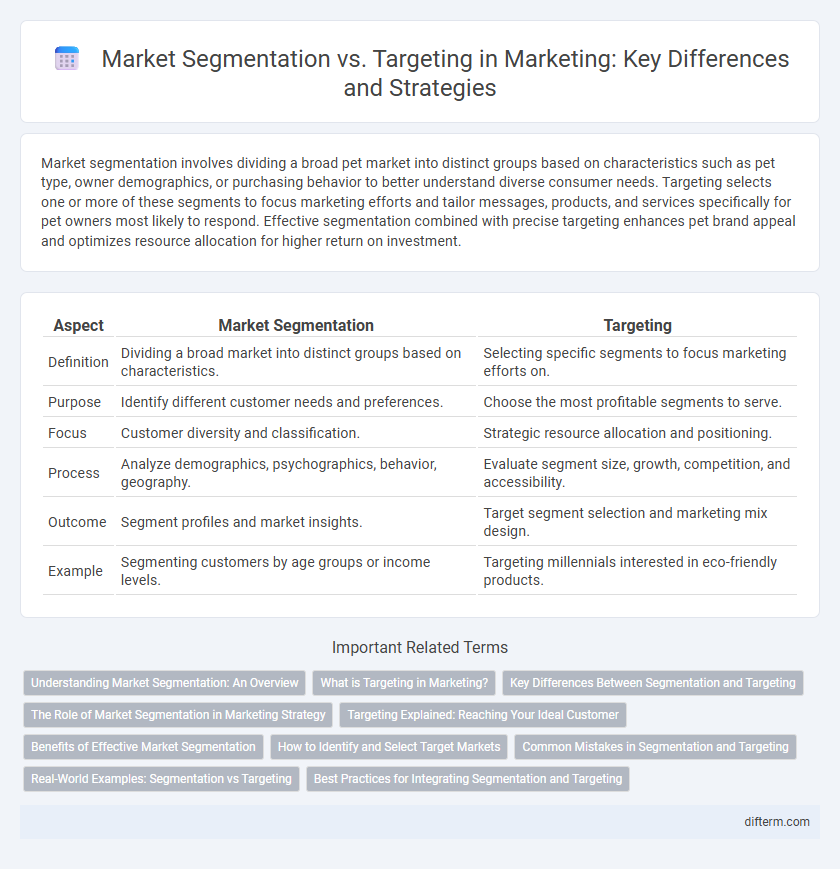Market segmentation involves dividing a broad pet market into distinct groups based on characteristics such as pet type, owner demographics, or purchasing behavior to better understand diverse consumer needs. Targeting selects one or more of these segments to focus marketing efforts and tailor messages, products, and services specifically for pet owners most likely to respond. Effective segmentation combined with precise targeting enhances pet brand appeal and optimizes resource allocation for higher return on investment.
Table of Comparison
| Aspect | Market Segmentation | Targeting |
|---|---|---|
| Definition | Dividing a broad market into distinct groups based on characteristics. | Selecting specific segments to focus marketing efforts on. |
| Purpose | Identify different customer needs and preferences. | Choose the most profitable segments to serve. |
| Focus | Customer diversity and classification. | Strategic resource allocation and positioning. |
| Process | Analyze demographics, psychographics, behavior, geography. | Evaluate segment size, growth, competition, and accessibility. |
| Outcome | Segment profiles and market insights. | Target segment selection and marketing mix design. |
| Example | Segmenting customers by age groups or income levels. | Targeting millennials interested in eco-friendly products. |
Understanding Market Segmentation: An Overview
Market segmentation divides a broad consumer or business market into sub-groups based on shared characteristics such as demographics, psychographics, or behavior patterns. This process enables marketers to identify specific needs and preferences within each segment, allowing for tailored product offerings and marketing strategies. Understanding market segmentation is essential for efficient resource allocation and improving customer engagement by addressing the unique demands of distinct market segments.
What is Targeting in Marketing?
Targeting in marketing involves selecting specific segments of a broader market to focus promotional efforts and resources on, based on factors such as demographics, behaviors, and needs. It enables businesses to tailor their messaging and product offerings to meet the precise preferences of chosen customer groups, enhancing engagement and conversion rates. Effective targeting increases marketing efficiency by concentrating resources on high-potential segments, driving better ROI and competitive advantage.
Key Differences Between Segmentation and Targeting
Market segmentation involves dividing a broad consumer or business market into sub-groups based on shared characteristics such as demographics, psychographics, or behavior. Targeting follows segmentation by selecting specific segments that align best with a company's product offerings and marketing objectives. The key difference lies in segmentation being a research-driven process to identify groups, while targeting is the strategic decision to focus marketing efforts on chosen segments for maximum impact.
The Role of Market Segmentation in Marketing Strategy
Market segmentation plays a crucial role in marketing strategy by dividing a broad consumer or business market into sub-groups based on shared characteristics such as demographics, psychographics, geographic location, and behavioral patterns. This segmentation enables companies to identify high-potential segments and tailor marketing efforts to address specific needs, preferences, and pain points, leading to more effective targeting. By precisely defining market segments, businesses can allocate resources efficiently, enhance customer engagement, and improve overall campaign ROI.
Targeting Explained: Reaching Your Ideal Customer
Targeting in marketing involves identifying and focusing on specific customer segments that are most likely to purchase a product or service, optimizing marketing efforts for better ROI. By analyzing demographic, psychographic, and behavioral data, businesses create personalized campaigns that resonate with their ideal customers. Effective targeting enhances customer engagement, maximizes conversion rates, and drives revenue growth by delivering tailored messages to well-defined audiences.
Benefits of Effective Market Segmentation
Effective market segmentation enables businesses to identify distinct consumer groups based on demographics, behavior, and preferences, leading to more personalized marketing strategies. Targeting these specific segments reduces marketing costs and improves campaign ROI by directing resources to high-potential audiences. Enhanced customer satisfaction and loyalty often result from delivering tailored messages and products that meet the unique needs of each market segment.
How to Identify and Select Target Markets
Market segmentation involves dividing a broad consumer or business market into sub-groups based on shared characteristics such as demographics, psychographics, geographic location, or behavior. Target market selection requires evaluating these segments for profitability, accessibility, size, and alignment with company objectives to concentrate marketing efforts efficiently. Leveraging data analytics and customer insights refines segment profiles and supports strategic decisions, optimizing resource allocation and maximizing return on investment.
Common Mistakes in Segmentation and Targeting
Common mistakes in market segmentation and targeting include overgeneralizing customer profiles, which dilutes marketing effectiveness and wastes resources. Failure to use data-driven insights often leads to targeting overly broad or irrelevant segments, reducing campaign ROI. Ignoring evolving consumer behavior and market trends results in outdated segmentation, missing potential high-value audiences.
Real-World Examples: Segmentation vs Targeting
Market segmentation divides a broad consumer market into distinct subsets based on demographics, behavior, or geography, as seen in Nike's segmentation by age and activity level. Targeting then selects specific segments to focus marketing efforts on, such as Nike targeting young athletes with performance-oriented products and campaigns. This approach enhances marketing efficiency by aligning product features and advertising with the preferences of the selected segment.
Best Practices for Integrating Segmentation and Targeting
Effective integration of market segmentation and targeting involves identifying distinct customer groups based on demographics, psychographics, and behavior to tailor marketing strategies precisely. Best practices include utilizing data analytics to refine segments, aligning messaging to address specific needs, and continuously monitoring segment performance for optimization. Leveraging customer insights ensures campaigns resonate deeply, improving conversion rates and maximizing ROI.
Market segmentation vs Targeting Infographic

 difterm.com
difterm.com